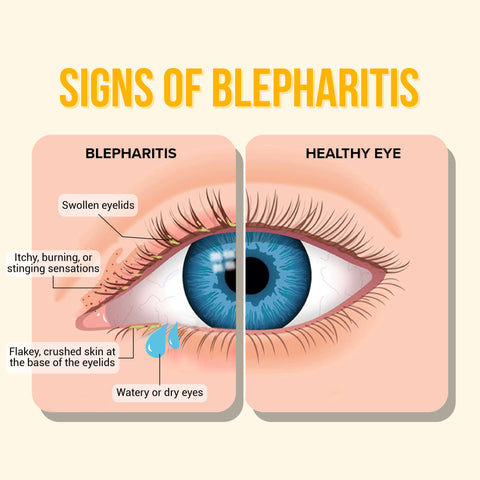Ah, eyelash extensions. They're the secret weapon for instant va-va-voom, taking our eyes from "eh" to "wow" with a flutter of feathery goodness. However, while we enjoy the compliments, a potential concern arises about the connection between blepharitis and eyelash extensions. In this blog, we'll delve into what blepharitis eyelid inflammation is and explore how it may be linked to eyelash extensions, ensuring that our eyes not only captivate but also remain healthy.
Can You Get Blepharitis from Eyelash Extensions?
Picture this: red and itchy in the eye area, swollen eyelids, crusty lashes that feel like sandpaper, and eyes that sting like someone sprinkled chili flakes. That's blepharitis, an inflammation of the eyelid margins that can make even the most stunning eyelash extensions feel like a prickly curse. Now, why does this party crasher love hanging out with eyelash extensions?
Well, there are a few reasons, the most common being an allergic reaction to the eyelash extension glue. We all know that these glues may contain certain chemicals, and for some sensitive souls, that translates to itchy and angry eyelids. And then there's the whole "foreign object in my eye" factor. Incorrect application of eyelash extensions adds extra weight and texture to your natural lashes, which can irritate the delicate skin around your eyes and clog oil glands, leading to that delightful grit-fest.
Identifying signs of Blepharitis on Eyelash extensions

So, how do you know if you have blepharitis from eyelash extensions? Keep an eye out for these telltale signs:
- Redness and swelling around your eyelids: Think puffy, angry lids that look like they got stung by a bee.
- Itchy, burning, or stinging sensations: Your eyes will feel like they're hosting an uncomfortable tingling sensation.
- Crusting along your lash line: Flaky bits clinging to your lashes like tiny barnacles? Not a good look.
- Watery or dry eyes: Blepharitis from eyelash extensions can throw your tear production off balance, leaving your eyes feeling like a desert or a leaky faucet.
- Increased sensitivity to light: Think of trying to watch a movie with a strobe light in your face. Not fun.
Blepharitis Prevention and Management Tips
FOR LASH ARTISTS
Maintaining strict hygiene is paramount in preventing and managing blepharitis caused by eyelash extensions. As a lash technician, follow these guidelines to safeguard your clients' eye health:
- Maintain strict hygiene: Always wash your hands thoroughly with soap and water before and after touching any client's eyes or eyelashes. Disinfect all of your tools and equipment after each use.
- Use high-quality lash products: Avoid using cheap, low-quality lashes and adhesives, as these can irritate the eyes and contribute to blepharitis. Choose products from reputable brands that are known for their safety and quality. And if you have a very sensitive client, try using a sensitive glue for them such as Forabeli's Pure-Sensitive Glue. This gentle adhesive uses a medical-grade adhesive that's kind to even the most delicate eyes so your clients can confidently flutter their lashes.
- Patch test the glue beforehand: Before committing to a full set, patch test your chosen lash extension glue by applying 5-10 extensions on each eye's outer lashes. Advise the client to watch for any itching, stinging, burning, or swelling within the next 24 hours.
For an in-depth guide on how to do a patch test for lash extensions, check out our detailed blog post “HERE’S WHY YOU SHOULD PATCH TEST YOUR CLIENTS.’' Your client’s eyes deserve the best care, so take the time to do a patch test and let them enjoy their stunning eyelash extensions worry-free!
Apply lashes carefully: Be careful not to get glue on your clients' skin or in their eyes. If you do accidentally get glue on their skin, especially their eyelids, remove it gently with a cotton swab dipped in an oil-free makeup remover.
Educate your clients about blepharitis: Let them know about the signs and symptoms of blepharitis, other possible reactions, and what they can do to prevent it. You can also provide them with tips for managing blepharitis at home.
Advise clients to see a doctor if they experience any symptoms: If a client experiences any symptoms of blepharitis, such as red, itchy, or irritated eyelids, advise them to see their doctor.
By following these guidelines, you can play a crucial role in preventing and managing blepharitis associated with eyelash extensions. Encourage clients to seek professional medical advice if any symptoms arise, ensuring a safe and beautiful lash experience for all.
FOR LASH CLIENTS
If you’re a lash client who is aiming to prevent blepharitis while enjoying eyelash extensions, here are some pro tips for you:
- Choose a skilled lash technician: Opt for a licensed professional lash technician who uses high-quality products and practices proper hygiene.
- Clean your lashes daily: Use a gentle, oil-free cleanser to remove makeup and debris without irritating your eyes.
- Take breaks from eyelash extensions: Give your eyes a breather every few weeks to let them recover and avoid build-up.
By incorporating these tips into your eyelash extension routine, you can avoid having blepharitis from eyelash extensions. Make informed choices, prioritize eye health, and revel in the captivating allure of your eyelash extensions.
Final Thoughts
Beautiful lashes and healthy eyes? Absolutely! By prioritizing gentle products, proper hygiene, and listening to your body, you can rock your eyelash extensions with confidence. Remember, treat your body with care for a beautiful life, starting with your most delicate features.

